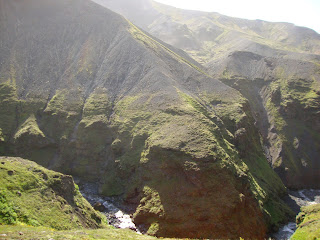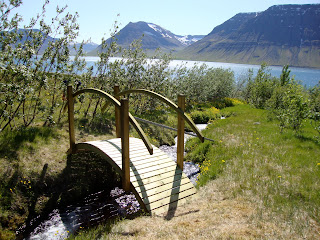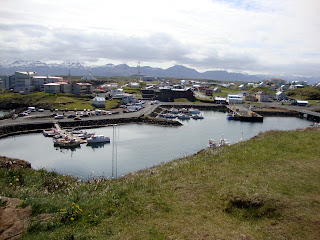I am writing this on the night before I leave. The apartment is—well—it is not clean yet, but I am pretty well packed, so I feel somewhat relaxed. So, I thought I’d write a little tale of my last weekend where, again adventures in the mountains made me wonder if I was going to make it back alive.
One of the fellows from my hiking group invited me to go to Thormork for two nights. This is an area where the group goes a lot and I have been there a couple of times now, once ten years ago when I hiked in along the remarkable “Catwalk” hike, and last year for their 35th year celebration. It is also a popular tourist area, and I am pleased to say, well managed by this hiking group. It is accessible only along a very rough dirt and ash Jeep track and one has to cross several rivers to get there. So tourist companies provide daily buses during the summers, using buses mounted on huge wheels, to take people in for the day.
The person who invited me was Jobbi, a man in his mid to late sixties, a veteran hiker and mountaineer, well known among outdoors people in Iceland for being the only person to have ever skied across Iceland alone during the winter. He did it when he turned fifty. He said we would perhaps do a hike one day and hang out with everyone there. It sounded lovely to me for my final weekend.
So we started on the hike along a canyon below the Catwalk, full of wild flowers on a sunny day.
As we walked up the canyon it got more rugged and narrow, jagged peaks above us.
Finally we reached the end and a beautiful shaft of a waterfall.
I was pleased. The hike had not been easy, being as there was, as usual, no trail and we had to scramble along the canyon walls, but I felt fine for the trip back.
But then Jobbi said, “We could go up that side canyon,” pointing to the left up to the Catwalk high above us, “or we could go up the other side. It is very interesting over there, a view and all.” I had, as I said, already walked the Catwalk. It is a narrow ridge, perhaps three feet wide or a bit more, and sweeps down a thousand feet on both sides. I remembered it well, so I decided I preferred to go to the right.
We started up the rock and ash. The way got exceedingly steep.
“Use your poles like this,” Jobbi said, “then you don’t have to crawl.” I didn’t think this was possible, but it got steeper. Then we came to a cliff. “Hmmm…” Jobbi said, “I’ve come up the wrong canyon arm. We should be there.” And he pointed down and across more lava rock faces. It looked impassible to me. “OK,” he said, “this is very steep (as if I hadn’t noticed). Your poles are two different lengths and you sink the lower one in like this and hold it on the top, not grasping it. And you don’t have the strap around your wrist because if you fall you want to be able to use it like this, like an ice axe.” He pointed, "And look, you can see the mountain you climbed last year."
We set off. I just let my mind go blank. I took no photos of this since the last thing I was going to do was pause or test my balance in any way. When we got across I did.
Then he said, “OK, for this last part, I want us to just slide.” I looked at him. “You slide on your front and you control the slide with the pole, think of it again like an ice axe.” He slid down and jumped to a rock at the bottom. I slide after him and ripped my hands to pieces. I ignored the bleeding and kept walking.
Finally we made it to the ridge.
I was ready to kiss the ground—which in fact I did because at the ridge a sixty-mile an hour wind hit us. I immediately sank to my hands and knees to avoid getting blown off the cliff. My sunglasses blew away.
“OK,” Jobbi said. “Think like a sheep here.” What? I do know that Jobbi grew up, like many Icelanders, herding sheep up and down the mountains. “They have four feet so they are much more stable than we are. So your poles are your other two feet. Put them downwind and dig in. If your poles are stable the wind can’t blow you over.” Right. We stumbled through the wind. Now I didn’t have my sunglasses and the ash started sand blasting my contacts.
“Is the other side as steep?” I asked.
“No, no,’ Jobbi said. “It’s grass.”
Grass grows on precipices.
I lengthened my poles for a descent and was almost bleating I was so much trying to think like a stable little sheep. We came to a rock.
“Shall we stop for something to eat?” Jobbi asked.
“No,” I said. “I will not be able to eat until we get off this grass wall.”
Finally we made it to the narrow track.
“We should be careful here,” Jobbi said. (How could I possibly be more careful than I was already exhausted from trying to be? The track was supposed to somehow be MORE dangerous than what we had just decended?) “I am a bit worried about this wind, it can burst along anywhere here, and it is a turbulent canyon. It can blow you right off. So let’s hurry a bit.” I hurried.
“We should be careful here,” Jobbi said. (How could I possibly be more careful than I was already exhausted from trying to be? The track was supposed to somehow be MORE dangerous than what we had just decended?) “I am a bit worried about this wind, it can burst along anywhere here, and it is a turbulent canyon. It can blow you right off. So let’s hurry a bit.” I hurried.
And finally, a view of Thorsmrok valley below.
My knee was wobbly but fine. I was shaky but not from exhaustion—although I was very tired later—but just the continual strain of holding off of panic for hour after hour.
The valley felt like home. The hiking club does a wonderful bonfire on Saturday nights and everyone was passing drinks around. I admit I got a bit drunk.
People started singing loud raucous verses of some song. “Is that a football song or something?” I asked.
“No,” Jobbi said, “Icelanders don’t sing football songs.” He started to laugh. “No, here is the song. There is this guy trying to get away with this bull and there are two trolls chasing him, a mother and her daughter. So first he throws down a hair from the bull and up rises a mountain to stop the trolls. But she gets a drill and drills a hole through the mountain. Then he throws down another hair, and a river rises up between them. So the trolls drink up all the river and come across. So, then he throws down a hair and a huge fire erupts. But then from all the water she drank from the river, the troll pees on it and puts out the fire.” He paused. “And it goes on like that.”
“Oh,” I said. No, not a football song.
The crowd had moved to another song. “This is a love song,” Jobbi said. “It is about a flower of the mountains but really it is a love song.”
“Where are all the foreigners?” I asked. “Everyone here seems to be Icelandic and I am sure there are some tourists staying here.”
“The tourists hike around the area and go to bed early. Icelanders stay up most of the night.”
Silly tourists, I thought. They are missing something wonderful here. I guess you just don’t sleep.
I crawled into my tent sometime about midnight and soon after the rain started. The volcano ash had been so heavy in the air the day before that it created a thick film over the entire tent (this area is right under where the volcano went off last year and ash is still everywhere). And still it rained. The next day the clouds hung low over the mountains and the forecast was more rain.
“We might as well go,” Jobbi said, “And the rivers will just get bigger. Sometimes they have to close the track.”
And indeed when we got to the river, a smaller Jeep, almost certain to be a tourist as Icelanders only come in the bigger Jeeps (that still have much lower gas mileage than the American ones I have to note). So the small Jeep had tried to cross, got caught in the glacial current, and was bobbing its way down the torrent. Two larger Icelander Jeeps came and managed to pull it out while Jobbi and I took photographs.
Then we started across.
But Jobbi knows what he is doing. After all he has been coming here for thirty-five years, winner and summer. Even through the raging white water I felt perfectly safe.
So, I made it back to Rvk in one piece again. And I think when I get back I should give a seminar on hiking pole use—think like a sheep.


































